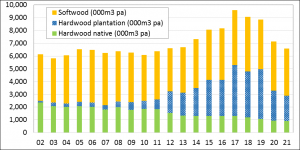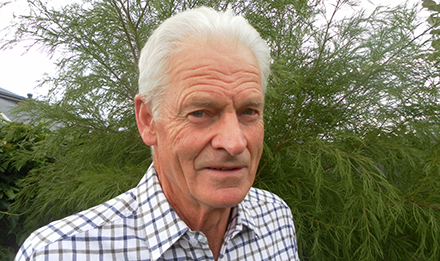The Victorian Government this week said it would minimise job impacts from the timber shortage and accelerate the Opal Maryvale mills transition away from native timber harvesting. Is this fact or fantasy?
The Victorian Governments Forestry Plan announced three years ago was trumpeted as a way to transition the timber industry from native forests to plantations within ten years. Apart from ignoring the biological fact that it would take 25-30 years for the new plantations to mature, the Plan was always a fantasy divorced from reality. The Plan ignored the challenges associated with plantation expansion in Gippsland, including insufficient suitable and affordable land within economic distance of mills and the poorer wood quality making a plantation-based resource unsuitable for many existing mills (1).
Over the first three years of the Forestry Plan, the government has delivered little more than announcements, coupe closures, declining plantation area, reduced log supply, timber shortages, mill shuts and the stand-down of timber workers. Opal’s Maryvale mill recently announced that it may have to shut its M5 paper machine involving 220 jobs, because it has run out of hardwood logs.
In 2019 the Victorian Government announced the Victorian ‘Forestry Plan’, a plan to transition the timber industry, reliant on logs from native forest, into logs supplied from new plantations.
On 27 July 2020 Premier Daniel Andrews announced a “Review to protect Victoria’s forests, jobs and timber industry” and the following statements were in that announcement:
- “The Victorian Government has commissioned a broad-ranging review to safeguard the Victorian Forestry Plan – and the regional jobs and environmental protections it will deliver”.
- “The 30-year plan sets out a long-term and sustainable future for Victoria’s forestry industry”.
- “Opal Australian Paper will also be supported to transition to a full plantation-based supply, ensuring it operates until at least 2050”.
- “The plan is backed by $120 million ….for re-employment and re-training impacted workers, funding for community projects that support local businesses and help create local jobs”.
- “Legal challenges have highlighted a range of issues that put the future of the plan at risk”.
In December 2022 the Victorian Government says it is actively engaging with Opal’s Maryvale Mill to minimise job impacts from the timber shortage and accelerate the mill’s transition away from native timber. The government says it is getting on with the job of delivering the Victorian Forestry Plan with more than $200 million in transition and investment support to timber businesses, workers and communities:
- Spending $85 million on local strategies, community development, business transition and innovation.
- Investing $120 million in a new plantation estate in Gippsland to support the sustainable future of forestry.
The Andrews governments Forestry Plan has delivered 50,000 less hectares of plantation rather than more plantation area. It has also delivered a huge 30% reduction in log supply from Victorian forests and plantations over the last few years (See table below), mostly embracing the period since the Forestry Plan was announced in 2019.

So the facts are:
- Total Victorian log supply from native forest, Hardwood plantation and Softwood plantation has declined by about 3 million m3 pa over the last few years.
- This has already contributed to the loss of about 3,300 direct jobs and 10,000 type 2 jobs (2).
- The Governments initial ‘fantasy supply’, Victorian plantation hardwood (eucalypt) log supply has declined by about 2 million m3 pa.
- The Victorian Governments ‘backup fantasy supply’, Victorian softwood log supply has declined by about 570,000 m3 pa.
- Victorian plantation area has shrunk by 50,000 ha over the last five years of which 22,000 ha is in Central Gippsland.
- The 14,000 ha promised on the eve of the November 2022 election, if implemented, will only deliver about 250,000 m3 pa and only in about 25-30 years’ time. It will only replace about a quarter of the area of plantation lost over the last five years, nor will the Forestry Plan replace the 1 million m3 of logs supplied from the native forests.
The loss of plantation area and the alarming decline in log supply, rather than expansion, is an indictment on the Andrews Governments Forestry Plan.
The industry support package announced by the Premier on 27 July 2020 appears to have shrunk from $120 million to $85 million now. This is only sufficient to provide support of about $23,000 for each of the 3,660 workers (3) dependent on native forest log supply.
Victoria’s misguided policies on forestry, bushfire mitigation, flood mitigation and rural roads continue to deliver underdevelopment of rural Victoria with profound adverse socioeconomic and environmental consequences.
John Cameron (Dip Hort. Burnley, MBA Monash, and tertiary units in economics, mathematics and statistics) is a forestry and business consultant previously holding positions in General Management, Corporate Development and Research in forestry and forest products. Former roles include Chairman of Private Forestry Gippsland, Chairman Southern Tree Breeding Association, Chairman Australian Research Group on Forest Genetics, Board Member CRC for Forestry Hobart & CRC for Pulp and Paper Science Monash.
(1) J. Cameron and R. Meynink (2008). Feasibility of timber currently harvested from Melbourne’s water catchments. Phase 1 – Resource and Timber Properties. Report to Department of Sustainability and Environment. J. Cameron and R. Meynink (2008). Feasibility of timber currently harvested from Melbourne’s water catchments. Phase 2 – Markets, supply, land and water. MBAC Report to Department of Sustainability and Environment.
(2) Direct jobs based on about 0.0011 jobs per m3 and Type 2 jobs (direct + production & consumption induced) based on about 0.0033 jobs per m3.
(3) J N Cameron (2020). Ecologically sustainable management of Victorian native forests. LC EPC Inquiry into Ecosystem Decline in Victoria, Submission 471.






